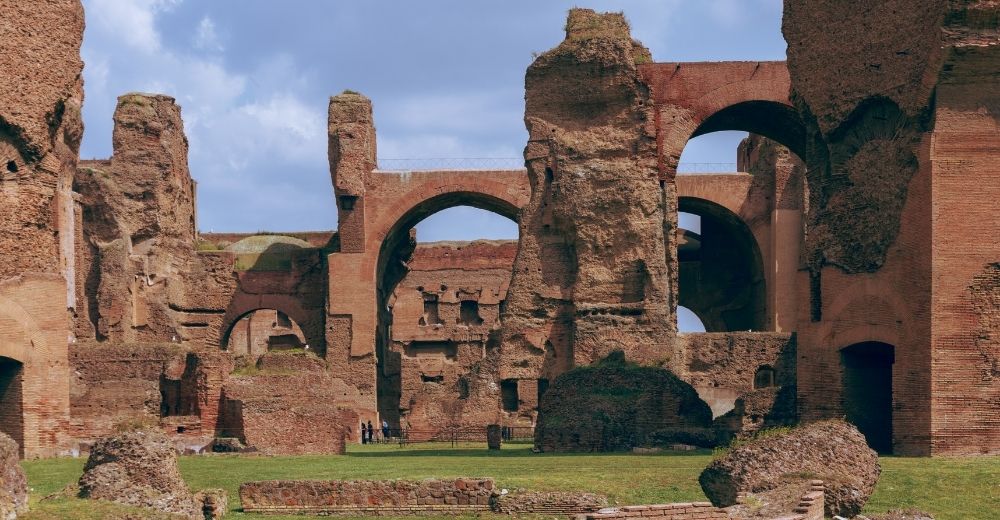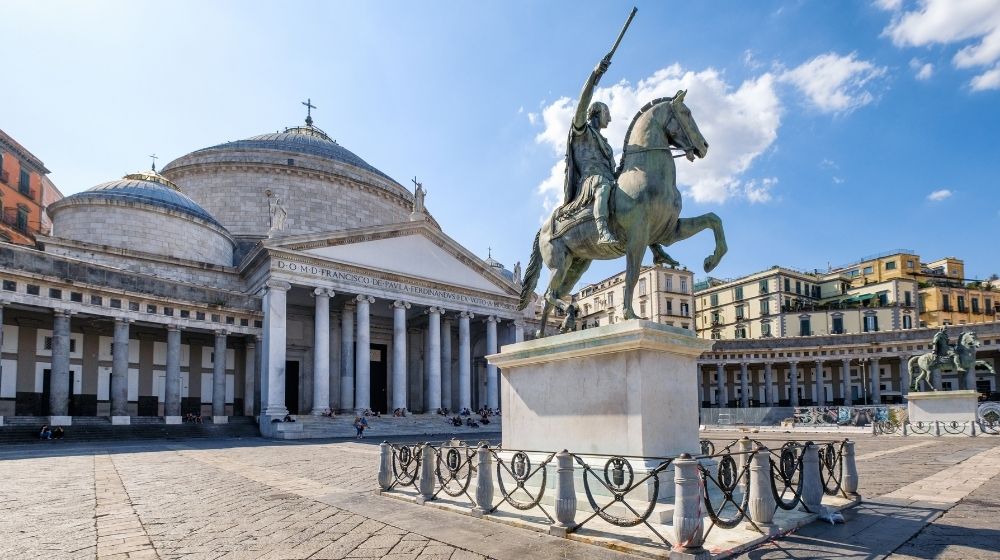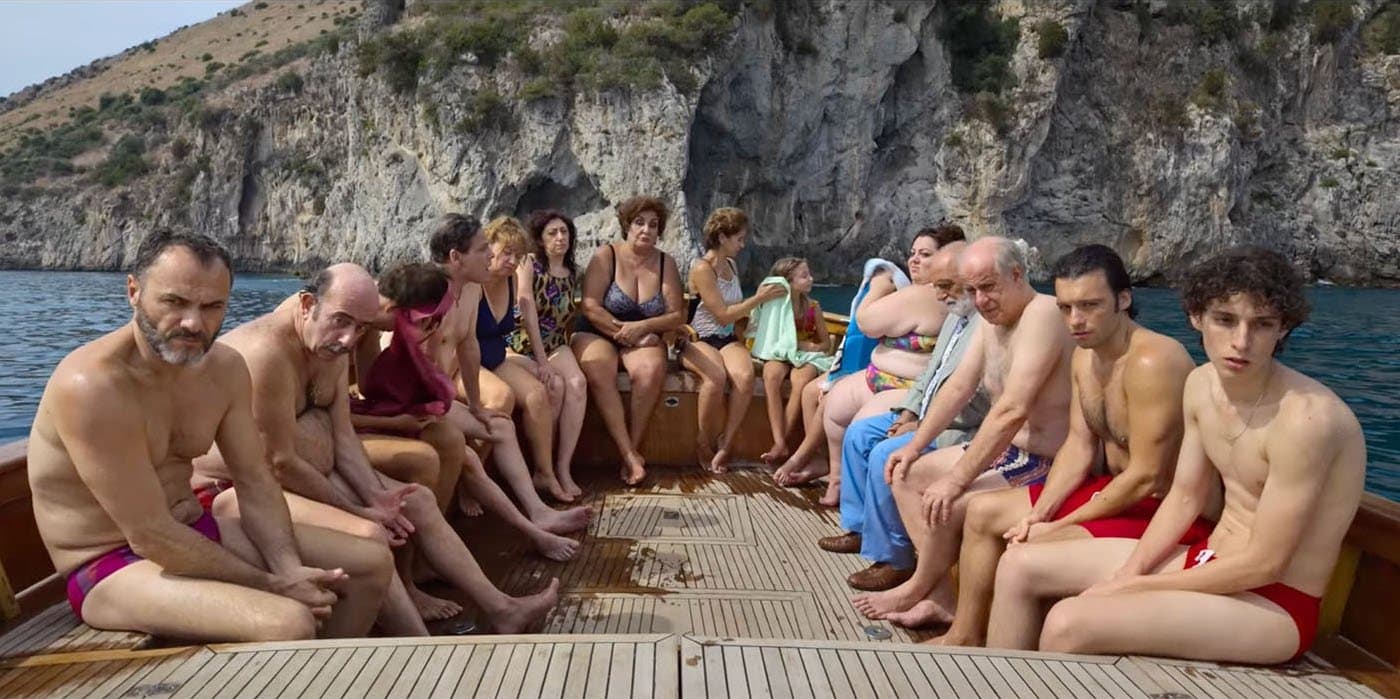He did it again.
Just 7 years after the victorious trip to Los Angeles for The Great Beauty, Paolo Sorrentino is back competing for an award.
The Hand of God is in fact nominated for the 2022 Oscars for Best Foreign Film.
Sorrentino has a stunning ability to center the events of his movies in certain locations, making the audience fall in love with these places.
In his best-known films, these places are really close to his heart: Rome represents his present, while Naples his past.
Jep Gambardella's walks in the best places in Rome in The Great Beauty resemble Sorrentino relaxing walks (by his own admission in an interview).
The way Naples is presented in The Hand of God is literally a window in the adolescence and most intimate moments of the director.
If you have been fascinated by the filming locations chosen for his films, enjoy this selection of the 15 most iconic places filmed by Paolo Sorrentino.
FInd out where your favourite scenes was shot!

15. Vomero neighbourhood (Naples)

A view of the hill Vomero district in Naples, home of Paolo Sorrentino.
In the list of locations close to Sorrentino's heart, the first to mention is the Vomero neighbourhood, a delightful and hilly district of Naples.
The director grew up in this corner of the city and, not surprisingly, he decided to shoot here at the Vomero many scenes for The Hand of God.
The Schisa family apartment used for filming is located in Via San Domenico: it's in the same building where Sorrentino lived with his family, just one floor higher than the real flat of the director.
This is really where true life meets cinema.
Another scene filmed in this area is the one where Aunt Patrizia is hospitalised. The building is the Domenico Martuscelli Institute, created to assist visually impaired people.
The Vomero is an elegant and quiet neighbourhood, offering great scenic views of Naples from the top. Vomero also features many landmarks: among others we recommend Castel Sant'Elmo, the Certosa di San Martino with the belvedere and the Museum of Ceramics.
14. Baths of Caracalla (Rome)

The Baths of Caracalla in Rome are the backdrop to one of the most surreal scenes of The Great Beauty.
Sorrentino sets the table for this scene showing us a giraffe and a magician, who makes the animal disappear with a "trick" right under the eyes of an astonished Toni Servillo.
A surreal and Fellini-like scene, where the time feels suspended for a moment, just like when Fabietto sees the man hanging from the roof of the Galleria Umberto I in The Hand of God.
The Baths of Caracalla are one of the most famous examples of imperial baths in Ancient Rome. This imposing structure is part of a bigger museum, also including the Tomb of Cecilia Metella and the Villa dei Quintili.
The thermal baths, which once served as a spa and gym for the Romans, are today a vast and well-preserved archaeological site, which leaves its visitors speechless.
The closest metro stop is Circo Massimo (line B) and the ticket to the Terme costs €10: the visit is highly recommended to history and archaeology buffs.
13. Stromboli island (Messina)

The steep side of the volcano in Stromboli.
Sorrentino evokes the power of Stromboli's volcano in a delicate moment in the life of Fabietto: how to start again after the family tragedy that struck them?
In the background, the dark and muffled noise of the lava explosions fills the ear, reminiscent of the dull pain of the two brothers.
The island of Stromboli was the holiday destination for the young Sorrentino and it's presented to us with the exact same terms: the sea, the hot summer and the typical black sand beaches.
In The Hand of God we can see the steep side of the volcano, called the Sciara di Fuoco, and then the port, the beaches and the rock of Strombolicchio.
The island of Stromboli and its volcano are a perfect summer destination.
Located in the Aeolian Islands, north of Messina, Stromboli is protected by UNESCO which recognises the special morphology of the territory and the presence of extraordinary flora and fauna.
This is not the first time that Stromboli features in a movie: Roberto Rossellini with Stromboli and Michelangelo Antonioni with L'avventura have used the beauty of the island as a backdrop for their movies.
Stromboli is a magical place, where visitors can get in touch with the wild side of the planet.
12. Via del Corso (Rome)

Via del Corso is one of the most important historical streets in Rome.
The street is an uninterrupted flow of tourists and Romans strolling at almost all hours of the day.
Almost two kilometers of straight road between Piazza del Popolo and Piazza Venezia: churches, historic buildings and renowned shops jostle for a spot in the sun in this vital artery of Rome.
In Il Divo, Sorrentino tells the story of Senator Giulio Andreotti, one of the key figure in the history of the Italian Republic.
In one of the few exterior shots in Rome, Sorrentino portrays Andreotti in one of his quiet morning walks.
Protected by his bodyguards, the senator walks along an empty via del Corso, before turning right towards Piazza di San Lorenzo in Lucina, entering the basilica to be confessed (and where he will pronounce the famous phrase: "Priests can vote, God cannot").
In real life, Andreotti's office was located in Piazza San Lorenzo in Lucina, at number 26.
If you are in Rome, we definitely recommend strolling along via del Corso and to follow our tips to enjoy the wonders of the Capital.
11. Parco degli Acquedotti (Rome)

The Parco degli Acquedotti is a beautiful green area south of Rome.
This park reminds us of the glory of Rome and the risk of losing the remains of the past due to the little attention we dedicate to preserve these locations: the park was in fact saved from decay just recently, making it a small oasis in the Appio Claudio district.
The park has appeared on the big screen on several occasions, including Fellini's La Dolce Vita. Sorrentino joins the list of directors using this location in The Great Beauty, shooting the scene of the outdoor theatrical performance of Talia Concept.
The protagonist of the film (Jep, Toni Servillo) attends the actress's show where she hits the wall of an aqueduct with her head: immediately afterwards Jep attempts a tragicomic interview with the same actress, where he is far from being impressed by her personality.
The presence of seven different aqueducts used by the ancient Romans makes the park a special place, where the symbols of antiquity mix with the beauty of the Roman countryside.
The Parco degli Acquedotti is the ideal place to get away from the chaos of the city, for a picnic or even a simple walk under the arches of the aqueducts.
10. Piazza del Plebiscito (Naples)

Piazza del Plebiscito is the largest square in Naples and one of its most iconic places.
The famous semicircular colonnade of the square embraces the basilica of San Francesco di Paola, with its neoclassical facade and dome inspired by the Pantheon in Rome.
The Royal Palace closes the square on the other side, leaving a huge pedestrian area in the centre, a space for public events and a meeting point for locals and tourists alike.
Surprisingly, Piazza del Plebiscito served as a car park and bus station until 1994: this is exactly how Sorrentino presents the square to us in The Hand of God.
An open window on the 1980s in Naples.
This is the surreal scene where Aunt Patrizia (Luisa Ranieri) meets San Gennaro on a vintage car, right at the bus stop in Piazza del Plebiscito.
9. Villa D'Abro (Naples)

The scene from The Hand of God filmed at dawn at Villa d'Abro in Posillipo.
Villa d'Abro is an historic villa in Naples, in the heart of the Posillipo district.
Sorrentino scouted the coastline for a filming location overlooking the sea and with an underground space: he found the perfect one in Villa d'Abro (in via Posillipo 46). The villa offered an ancient basement with an outlet to the sea, perfect for one of the key scenes of The Hand of God.
In this dark “water cathedral", Sorrentino sets the dialogue between Fabietto and director Antonio Capuano, where the young man is pushed by the master to find the right inspiration to make cinema.
The scene is beautiful and meaningful: it begins in the darkness of the cistern and, through a small door overlooking the Gulf of Naples, takes the audience from closure to openness, from the doubts of the young Fabietto/Sorrentino to his artistic maturity.
The mater's dive into the sea at dawn seals the deal.
Posillipo is one of the most iconic neighbourhoods of Naples and offers a variety of attractions: terraces with unforgettable views, boat tours, green areas and luxurious villas.
8. Colosseum and Imperial Fora (Roma)

The Colosseum and the Imperial Fora take the entire view from the terrace of Jep Gambardella (Toni Servillo) in The Great Beauty.
Jep's house is located in a wonderful penthouse in Piazza del Colosseo at number 6, and in the movie we can see right next to it the the park San Gregorio al Celio and the busy road via Celio Vibenna.
The terrace scene offers a glimpse of Rome with both its ancient and modern sides, even if the protagonist is barely glancing at it, fully absorbed by his personal crisis. In fact, the Colosseum appears to us almost like a skeleton, projected into the present from a bygone era to remind Jep how thin is the line between life and death.
Finally, in the most poetic moment of the film, the Colosseum appears again at sunset in the scene of migrating flamingos, pushed by the breath of the “Saint”.
The last show in the Flavian Amphitheater is dated 523 AD. But the Colosseum is still present in our collective imaginary and in the many films on Ancient Rome: it's one of the most iconic buildings in the world, with its two thousand years of history and unmistakable shape.
So you now really want to visit the Colosseum?
7. Capitoline Museums (Rome)

The statue of Marforio, used for the cover of The Great Beauty.
In The Great Beauty, Sorrentino filmed a scene halfway between dream and reality in which Toni Servillo and Sabrina Ferilli end up exploring the Capitoline Museums at night.
The character played by Giorgio Pasotti, a man trusted by rich and powerful people, always carries a dark suitcase with the keys to the most beautiful buildings in Rome.
He is a sort of guardian of the "great beauty" of the capital, taking the two protagonists on an unlikely nightly visit to the museum.
In the movie, the talking statue of Marforio stands out in the courtyard of the Palazzo Nuovo (also used for the cover of the movie) and the Capitoline Galata, a marble copy of the original dying Galata of Greek origin. This is just two of the thousands statues and pieces of art housed by this museum.
Nothing to say, the Capitoline Museums are the main museum of Rome, absolutely unmissable if you are visiting the eternal city.
6. Diego Armando Maradona Stadium (Napoli)
Sorrentino is a football fan and a big supporter of SSC Napoli.
The impact of Maradona's arrival at Napoli echoes in many moments of The Hand of God: from the dream of buying the best player in the world to the happiness when the deal was made, up to the key moment: Fabietto goes to Empoli to follow Maradona and therefore doesn't take part in the tragic family trip to Roccaraso.
Anyway, Sorrentino says he's grateful to Diego Maradona for saving his life.
Formerly known as Stadio San Paolo, nowadays the stadium is named after Diego Armando Maradona: Sorrentino filmed two scenes here.
The first is when Fabietto and his brother attend Napoli's training session and Maradona scores all his free-kicks, shocking the two boys for his "perseverance". The second time is when Fabietto meets the smuggler he had first seen at the rock of Isca, starting that strange friendship.
5. Tempietto del Bramante (Rome)

The Tempietto of San Pietro in Montorio is a jewel of Renaissance architecture on the Janiculum hill, a stone's throw away from Trastevere.
The temple is located inside the cloister of the namesake convent: it's here that Jep (Toni Servillo) meets a mother who is anxiously searching for her daughter, playing hide-and-seek in the darkness of the crypt - a scene suspended between dream and reality.
This monument features an extraordinary dome and it was built with classical forms by Donato Bramante around 1507. The access to the crypt was completed by Bernini just a hundred years later.
At the centre of the crypt there is a hole which is presumed to be the place where the Romans planted the cross of the martyrdom of St. Peter.
Admission to the Church of San Pietro in Montorio and its temple is free, but the crypt is not always accessible due to the restoration works.
4. Aventino neighbourhood (Rome)

St. Peter's dome from the keyhole on the Aventino hill.
The Aventino neighbourhood is a sought-after and elegant residential area of Rome, featuring a rich architectural heritage away from the chaotic city centre.
Sorrentino draws heavily on this wealth by filming in the Aventino two scenes from The Great Beauty.
The first is when Jep walks in front of the Basilica of Santa Sabina, one of the best preserved early Christian churches in Rome, dating back to 427 BC! Immediately after you can admire the Giardino degli Aranci ("Garden of oranges") where a nun on a ladder picks the lemons.
Finally, in one of the most hidden places of Rome, Toni Servillo and Sabrina Ferilli see the dome of St. Peter's Basilica through the keyhole of the Villa del Priorato di Malta. Thanks to the optical effect created by the row of trees and the small hole, the Dome seems huge and very close to the observer.
A few meters away from the Villa, there is the recently built Church of Sant’Anselmo, where Sorrentino shot several interiors for the series The Young Pope with Jude Law.
With your camera at hand, we strongly suggest exploring the Aventino and visit in this order the Giardino degli Aranci, the Basilica of Santa Sabina and the Villa del Priorato: these buildings are all on the same road, a few hundred meters from each other (Via di Santa Sabina).
3. Fontana dell’Acqua Paola (Rome)

The Fontana dell’Acqua Paola is a monumental fountain on the Janiculum hill in Rome, better known as the "fountain".
Sorrentino sets around the fountain the opening scene of The Great Beauty, accompanied by the song "I lie" interpreted by a female choir.
A guide talks to a group of Japanese tourists showing the beautiful panorama that can be enjoyed from the Janiculum hill, right in front of the fountain, when suddenly a tourist faints (perhaps because of the sun, or because of the excessive beauty of the landscape).
The fountain was commissioned by Pope Paul V and was built by Giovanni Fontana in 1610 in marble and granite. Five powerful water jets fill five marble basins which in turn feed the main basin in a cascade.
Today it is very popular with tourists, especially at sunset or in the evening, thanks to its splendid night lighting.
2. Islet of Isca (Massa Lubrense)

The scene from The Hand of God filmed at the Isca islet.
The Amalfi coast is beautifully portrayed by Sorrentino in The Hand of God.
The crystal clear waters around the islet of Isca and the Crapolla fjord are the backdrop of the Schisa family's boat trip, near Massa Lubrense.
This is where Toni Servillo declares eternal love to his wife and where Aunt Patrizia sunbathes naked, making Fabietto lose his head.
Isca is not too far from Punta Campanella and is considered halfway between an island and a rock: it has been owned for years by Eduardo De Filippo, a famous actor and play-writer who wrote here several of his works.
Visitors can swim around the islet of Isca or admire it from above, in both cases it is an evocative and unmissable experience if you are in the area.
To get there, you have to take the CAI 344 trail, starting from Sorrento to the Crapolla fjord: the descent might be steep, with almost 800 steps and some incredible views of the sea, overlooking the steep mountain ridges.
The reward for the effort of the descent is a delightful little beach in the fjord and, from there, in a few strokes you can enjoy a swim around the rock.
1. Galleria Umberto I (Naples)

Majestic and elegant, the Galleria Umberto I in Naples plays an important symbolic role in The Hand of God.
This is a location strictly connected with love.
Firstly because this is the place where Fabietto falls in love with cinema, seeing for the first time a live film set by Antonio Capuano, Neapolitan director and Sorrentino's master.
The boy's passion for cinema represents therefore the opportunity to escape from that sad reality of his present.
In addition, the gallery is also a place of love for Fabietto's parents, as they met for the first time in Piazzetta Serao, next to the Gallery.
Halfway between a shopping centre and a monument, the Galleria Umberto I is one of the most iconic palaces of Naples, with its famous iron and glass dome: built in 1890, the gallery is dedicated to King Umberto I of Italy to commemorate the help to the city during the cholera epidemic of 1884. The rebuilding works that improved Naples in those years, in fact, led to the construction of the gallery, replacing a block of ill-famed buildings.
Today the Galleria Umberto I is an unmissable landmark for those visiting the Naples, an oasis of class and peace in the crowded city centre, a stone's throw from the San Carlo Theatre and Piazza del Plebiscito.
The gallery is protected by UNESCO along with the rest of the historic city center: get inspired with our tips on what to see in the city center in Naples.
About the author
Written on 19/03/2022




Fabrizio Mariani
Are you intrigued by the filming locations used by director Paolo Sorrentino? Then let’s find out his 15 most iconic movie locations.